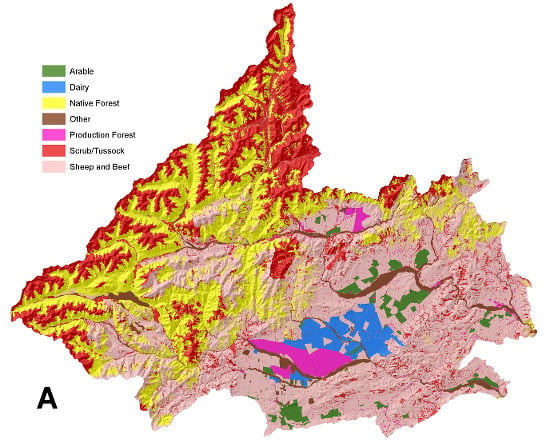Simulation vs. Definition: Differing Approaches to Setting Probabilities for Agent Behaviour
Abstract
:1. Introduction
2. Methods
2.1. Survey Research
| Variables | Mean | Std. Dev. | Min. | Max. |
|---|---|---|---|---|
| intend to intensify over the following 5 years (1–10) | 2.678 | 3.046 | 0 | 10 |
| intend to de-intensify over the following 5 years (1–10) | 3.569 | 3.452 | 0 | 10 |
| effective land quantity (hectares) | 486.440 | 1932.137 | 2 | 34,000 |
| age (years) | 56.471 | 10.098 | 24 | 87 |
| experience (years) | 25.100 | 15.812 | 1 | 66 |
| high school education (dummy) | 0.393 | 0.488 | 0 | 1 |
| diploma/tech training (dummy) | 0.278 | 0.448 | 0 | 1 |
| university or higher (dummy) | 0.329 | 0.470 | 0 | 1 |
| importance of being highly productive (1–10) | 6.535 | 2.787 | 0 | 10 |
| profitable business (dummy) | 0.785 | 0.411 | 0 | 1 |
| respondent exceeds median # of farm/farmer visits (dummy) | 0.487 | 0.500 | 0 | 1 |
| risk tolerance (1–10) | 5.437 | 2.403 | 0 | 10 |
| enterprise = sheep and beef (share) | 0.444 | 0.497 | 0 | 1 |
| enterprise = dairy (share) | 0.209 | 0.407 | 0 | 1 |
| enterprise = deer and other livestock (share) | 0.035 | 0.183 | 0 | 1 |
| enterprise = horticulture and viticulture (share) | 0.107 | 0.309 | 0 | 1 |
| enterprise = arable (share) | 0.030 | 0.171 | 0 | 1 |
| enterprise = dairy support (share) | 0.045 | 0.207 | 0 | 1 |
| enterprise = forestry (share) | 0.079 | 0.270 | 0 | 1 |
| enterprise = other enterprise (share) | 0.052 | 0.222 | 0 | 1 |
| number of land uses on this operation (#) | 1.684 | 0.884 | 1 | 5 |
| region = Auckland (share) | 0.031 | 0.173 | 0 | 1 |
| region = Bay of Plenty (share) | 0.054 | 0.226 | 0 | 1 |
| region = Canterbury (share) | 0.178 | 0.382 | 0 | 1 |
| region = Gisborne (share) | 0.024 | 0.154 | 0 | 1 |
| region = Hawke's Bay (share) | 0.084 | 0.277 | 0 | 1 |
| region = Marlborough (share) | 0.057 | 0.232 | 0 | 1 |
| region = Manuwatu-Whanganui (share) | 0.066 | 0.249 | 0 | 1 |
| region = Northland (share) | 0.053 | 0.224 | 0 | 1 |
| region = Otago (share) | 0.128 | 0.334 | 0 | 1 |
| region = Southland (share) | 0.086 | 0.280 | 0 | 1 |
| region = Tasman and Nelson (share) | 0.067 | 0.250 | 0 | 1 |
| region = Taranaki (share) | 0.043 | 0.203 | 0 | 1 |
| region = Waikato (share) | 0.074 | 0.262 | 0 | 1 |
| region = Wellington (share) | 0.036 | 0.186 | 0 | 1 |
| region = West Coast (share) | 0.020 | 0.139 | 0 | 1 |
2.2. Defining the Likelihood of Land-Use Conversion
2.2.1. Homogeneous Approach
2.2.2. Network Approach
2.2.3. Survey Approach
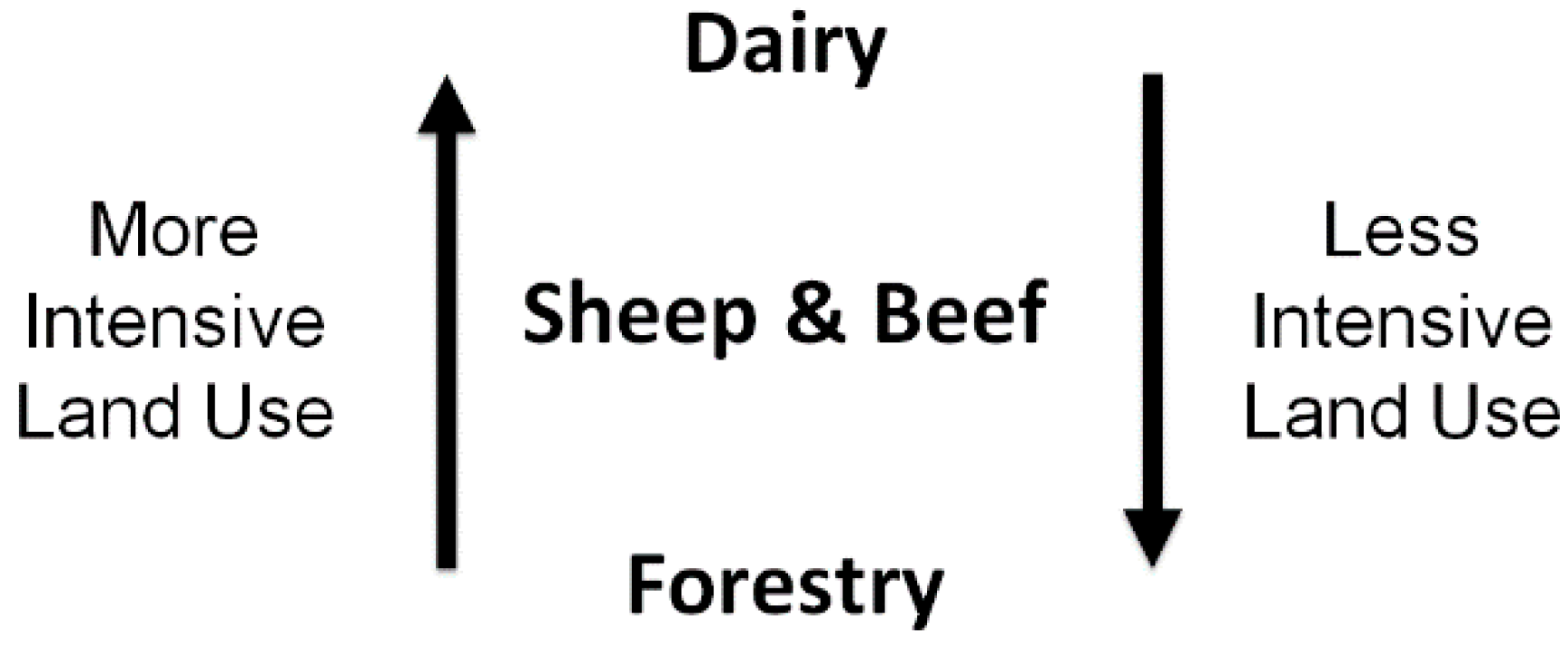
| Variables | Intensify | De-Intensify |
|---|---|---|
| log of effective land quantity | 0.206 * | 0.150 |
| (0.105) | (0.118) | |
| log of age | –3.374 *** | –0.0697 |
| (0.767) | (0.923) | |
| log of experience | 0.380 *** | 0.352 ** |
| (0.145) | (0.164) | |
| diploma/tech training | 0.570 * | –0.337 |
| (0.329) | (0.370) | |
| university or higher | 0.295 | –0.159 |
| (0.323) | (0.373) | |
| importance of being highly productive | 0.140 ** | –0.0216 |
| (0.0605) | (0.0657) | |
| profitable business | –0.842 ** | –0.342 |
| (0.373) | (0.410) | |
| respondent exceeds median # of farm/farmer visits | 1.272 *** | 0.787 ** |
| (0.286) | (0.328) | |
| risk tolerance | 0.179 *** | 0.0248 |
| (0.0619) | (0.0705) | |
| Constant | 6.874 ** | –3.812 |
| (3.330) | (3.988) | |
| Enterprise dummies | YES | YES |
| Region dummies | YES | YES |
| Observations | 1,507 | 1,507 |
| McFadden’s adjusted R-squared | 0.0449 | 0.0182 |
3. Experimental Section
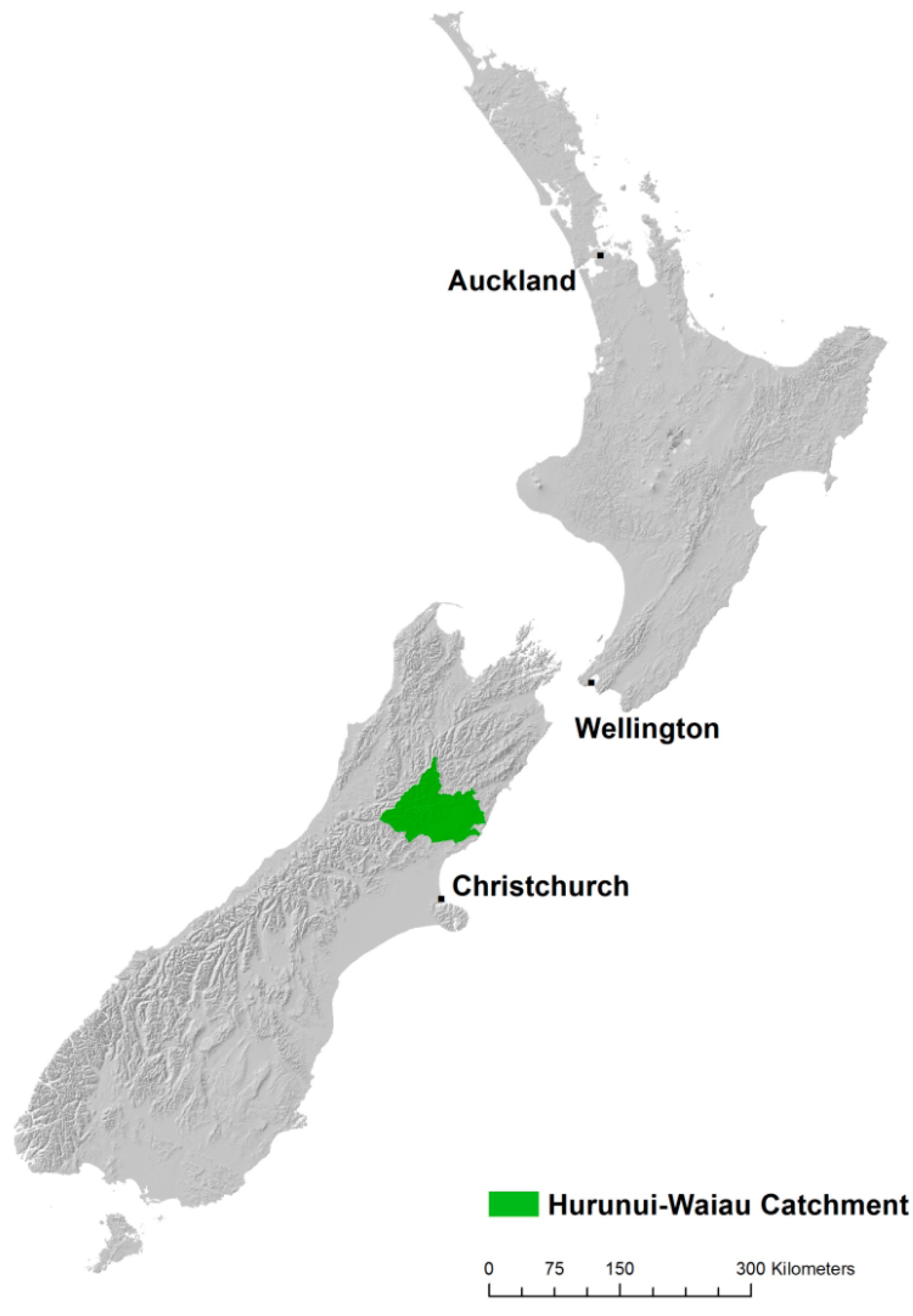
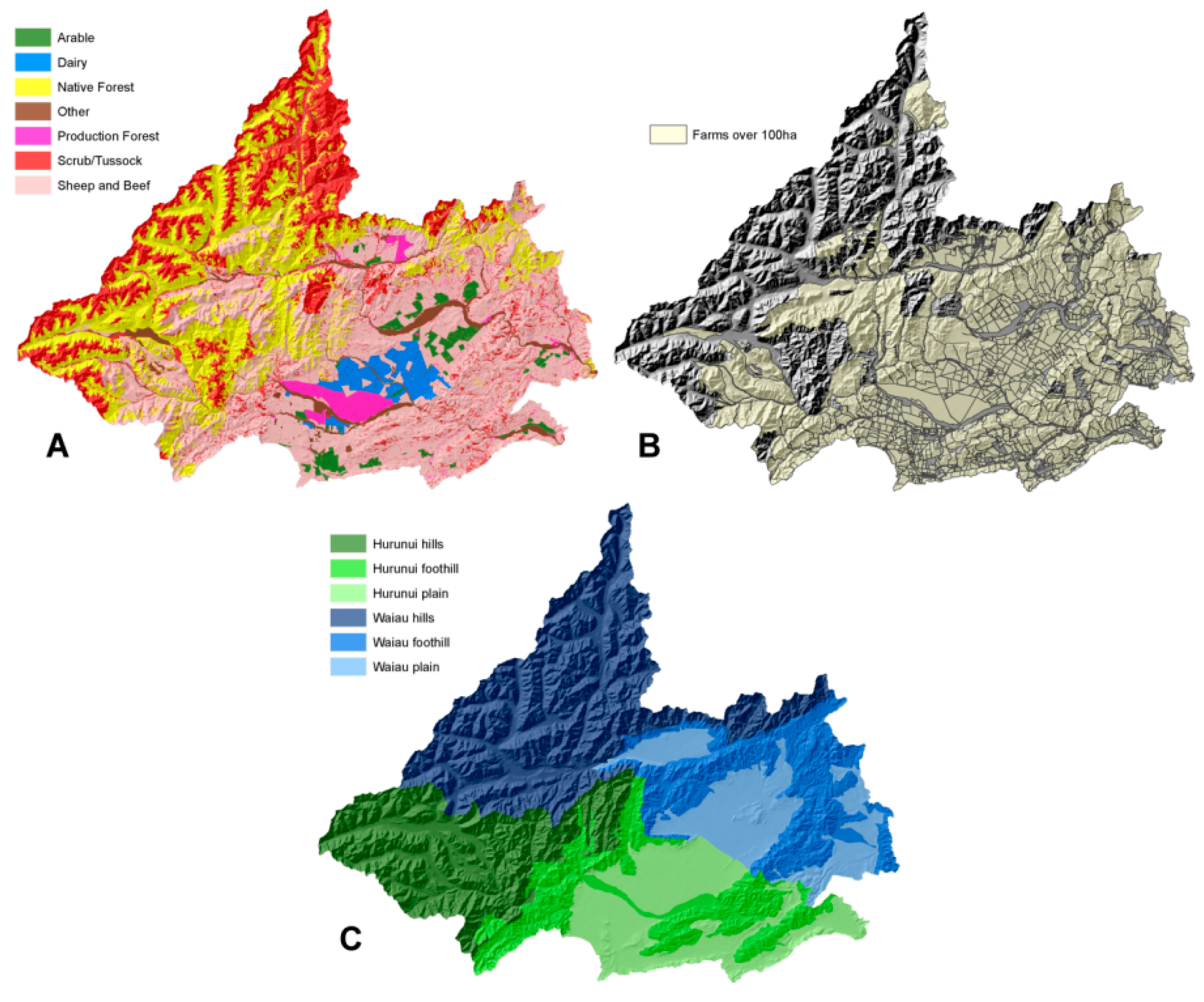
| Forestry | Sheep and Beef | Dairy | |
|---|---|---|---|
| Intensify | 12.99% | 26.12% | 31.06% |
| De-Intensify | 0.00% | 29.10% | 26.99% |
4. Results
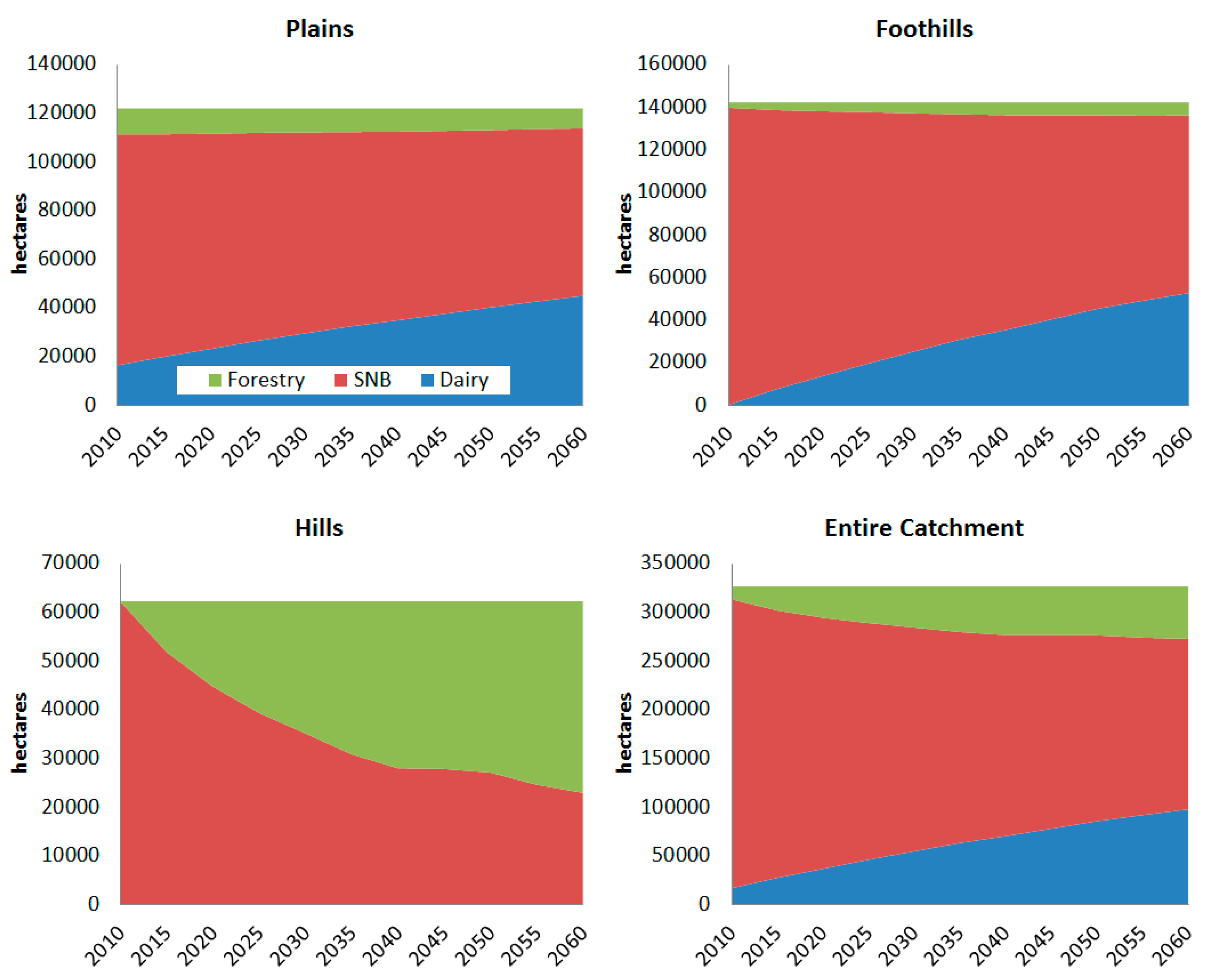

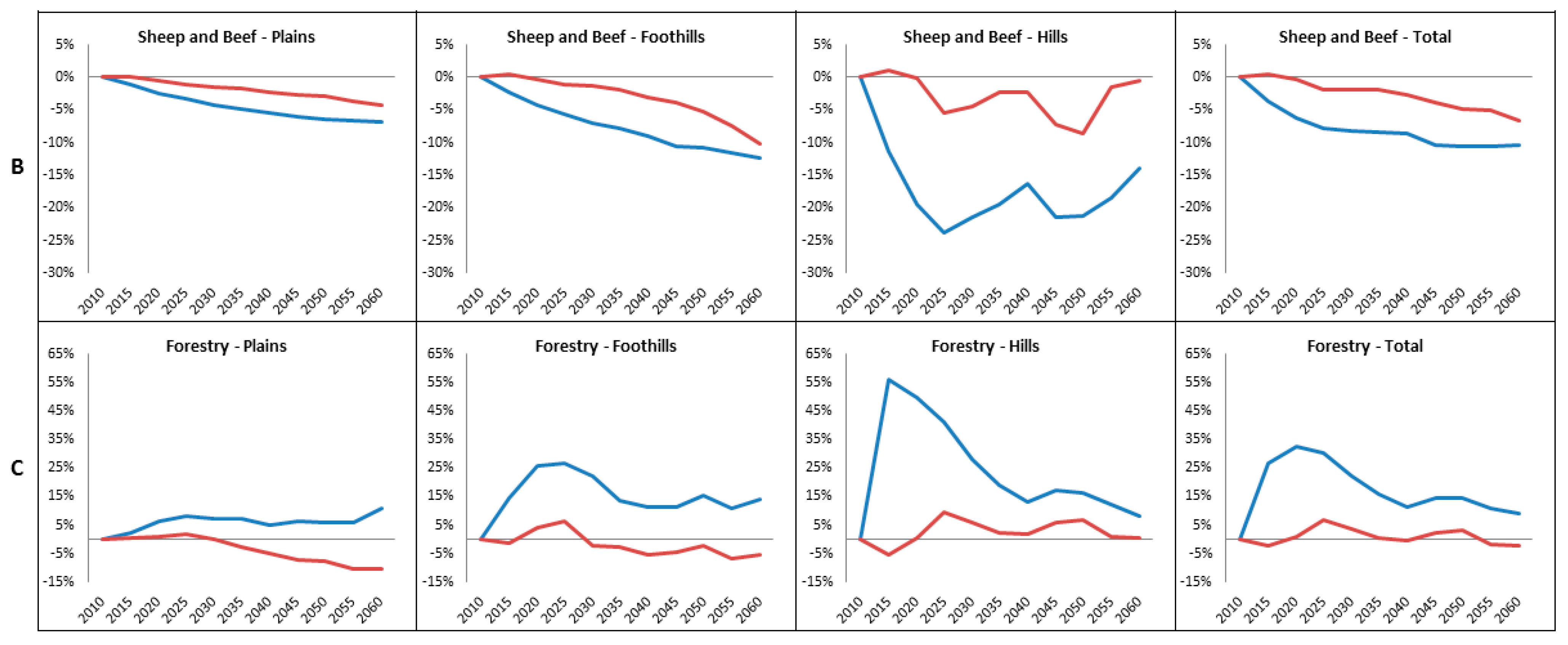
4.1. Farm Net Revenue
| Year | Total | Dairy | Sheep and Beef | Forestry | ||||||||
|---|---|---|---|---|---|---|---|---|---|---|---|---|
| Homo | Networks | Survey | Homo | Networks | Survey | Homo | Networks | Survey | Homo | Networks | Survey | |
| 2010 | $153 | 0.0% | 0.0% | $30 | 0.0% | 0.0% | $115 | 0.0% | 0.0% | $7 | 0.0% | 0.0% |
| 2020 | $214 | 0.9% | 6.6% | $83 | 1.2% | 15.3% | $110 | 1.8% | –6.8% | $21 | 0.0% | 25.0% |
| 2030 | $308 | 3.1% | 7.8% | $156 | 4.3% | 15.7% | $118 | 1.7% | –10.3% | $34 | 2.9% | 19.0% |
| 2040 | $421 | 4.5% | 8.7% | $246 | 7.2% | 16.0% | $126 | 1.6% | –10.5% | $49 | –2.1% | 9.3% |
| 2050 | $568 | 4.9% | 8.4% | $369 | 7.1% | 14.0% | $139 | 0.0% | –14.9% | $60 | 1.6% | 13.0% |
| 2060 | $745 | 7.3% | 7.7% | $514 | 11.4% | 12.7% | $153 | –3.4% | –15.9% | $78 | –1.3% | 9.3% |
4.2. Environmental Outputs
| Year | Livestock GHGs | Forest Carbon Sequestration | Net GHGs | ||||||
|---|---|---|---|---|---|---|---|---|---|
| Homogenous | Network | Survey | Homogenous | Network | Survey | Homogenous | Network | Survey | |
| 2010 | 988,619 | 988,619 | 988,619 | –200,686 | –200,686 | –200,686 | 787,933 | 787,933 | 787,933 |
| 2020 | 1,009,062 | 1,027,099 | 1,007,832 | –517,043 | –502,681 | –677,464 | 492,020 | 524,418 | 330,368 |
| 2030 | 1,052,232 | 1,080,009 | 1,060,729 | –682,562 | –697,085 | –833,184 | 369,670 | 382,924 | 227,545 |
| 2040 | 1,080,496 | 1,125,738 | 1,113,336 | –807,773 | –792,856 | –896,421 | 272,723 | 332,881 | 216,915 |
| 2050 | 1,134,640 | 1,179,598 | 1,164,413 | –810,228 | –821,304 | –930,562 | 324,412 | 358,294 | 233,851 |
| 2060 | 1,166,265 | 1,238,713 | 1,201,127 | –867,407 | –847,212 | –947,868 | 298,859 | 391,501 | 253,259 |
| Year | Nitrogen | Phosphorus | ||||
|---|---|---|---|---|---|---|
| Homogenous | Network | Survey | Homogenous | Network | Survey | |
| 2010 | 4039 | 4039 | 4039 | 37 | 37 | 37 |
| 2020 | 4899 | 4970 | 5171 | 40 | 41 | 41 |
| 2030 | 5701 | 5882 | 6115 | 44 | 45 | 45 |
| 2040 | 6339 | 6652 | 6899 | 46 | 49 | 49 |
| 2050 | 7009 | 7370 | 7599 | 50 | 53 | 53 |
| 2060 | 7517 | 8136 | 8111 | 53 | 57 | 56 |
5. Conclusions
Supplementary Files
Supplementary File 1Acknowledgements
Author Contributions
Conflicts of Interest
References
- Smajgl, A.; Brown, D.G.; Valbuena, D.; Huigen, M.G.A. Empirical characterisation of agent behaviours in socio-ecological systems. Environ. Model. Softw. 2011, 26, 837–844. [Google Scholar] [CrossRef]
- Parker, D.C.; Manson, S.M.; Janssen, M.A.; Hoffmann, M.J.; Deadman, P. Multi-agent systems for the simulation of land-use and land-cover change: A review. Ann. Assoc. Am. Geogr. 2003, 93, 314–337. [Google Scholar] [CrossRef]
- Villamor, G.B.; van Noordwijk, M.; Troitzsch, K.G.; Vlek, P.L. Human decision making for empirical agent-based models: Construction and validation. In Proceedings of the International Environmental Modelling and Software Society (iEMSs)—2012 International Congress on Environmental Modelling and Software, Leipzig, Germany, 1–5 July 2012.
- Hersperger, A.M.; Gennaio, M.-P.; Verburg, P.H.; Bürgi, M. Linking land change with driving forces and actors: Four conceptual models. Ecol. Soc. 2010, 15, 1. [Google Scholar]
- Lambin, E.F.; Turner, B.L.; Geist, H.J.; Agbola, S.B.; Angelsen, A.; Bruce, J.W.; Coomes, O.T.; Dirzo, R.; Fischer, G.; Folke, C.; et al. The causes of land-use and land-cover change: Moving beyond the myths. Glob. Environ. Chang. 2001, 11, 261–269. [Google Scholar] [CrossRef]
- Rindfuss, R.R.; Walsh, S.J.; Turner, B.L.; Fox, J.; Mishra, V. Developing a science of land change: Challenges and methodological issues. Proc. Natl. Acad. Sci. USA 2004, 101, 13976–13981. [Google Scholar] [CrossRef] [PubMed]
- Brown, D.G.; Verburg, P.H.; Pontius, R.G., Jr.; Lange, M.D. Opportunities to improve impact, integration, and evaluation of land change models. Curr. Opin. Environ. Sustain. 2013, 5, 452–457. [Google Scholar] [CrossRef]
- Agarwal, C.; Green, G.M.; Grove, J.M.; Evans, T.P.; Schweik, C.M. A Review and Assessment of Land-Use Change Models: Dynamics of Space, Time, and Human Choice; U.S. Department of Agriculture Forest Service, Northeastern Forest Research Station: Burlington, VT, USA, 2002. [Google Scholar]
- Baker, W.L. A review of models in landscape change. Landsc. Ecol. 1989, 2, 111–133. [Google Scholar] [CrossRef]
- Veldkamp, A.; Lambin, E.F. Predicting land-use change. Agric. Ecosyst. Environ. 2001, 85, 1–6. [Google Scholar] [CrossRef]
- Chuvieco, E. Integration of linear programming and GIS for land-use modeling. Int. J. Geogr. Inf. Syst. 1993, 7, 71–83. [Google Scholar] [CrossRef]
- Longley, P.; Higgs, G.; Martin, D. The predictive use of GIS to model property valuations. Int. J. Geogr. Inf. Syst. 1994, 8, 217–235. [Google Scholar] [CrossRef]
- Sklar, F.H.; Costanza, R. The development of dynamic spatial models for landscape ecology: A review and prognosis. In Quantitative Methods in Landscape Ecology; Tuner, M.G., Gardner, R.H., Eds.; Springer-Verlag: New York, NY, USA, 1991; pp. 239–288. [Google Scholar]
- Weinberg, M.; Kling, C.L.; Wilen, J.E. Water markets and water quality. Am. J. Agric. Econ. 1993, 75, 278–291. [Google Scholar] [CrossRef]
- Leggett, C.G.; Bockstael, N.E. Evidence of the effects of water quality on residential land prices. J. Environ. Econ. Manag. 2000, 39, 121–144. [Google Scholar] [CrossRef]
- Parker, D.C.; Filatova, T. A conceptual design for a bilateral agent-based land market with heterogeneous economic agents. Comput. Environ. Urban Syst. 2008, 32, 454–463. [Google Scholar] [CrossRef]
- O'Sullivan, D.; Haklay, M. Agent-based models and individualism: Is the world agent-based? Environ. Plan. A 2000, 32, 1409–1425. [Google Scholar] [CrossRef]
- Nolan, J.; Parker, D.; van Kooten, G.C.; Berger, T. An overview of computational modeling in agricultural and resource economics. Can. J. Agric. Econ. 2009, 57, 417–429. [Google Scholar] [CrossRef]
- Caldas, M.; Walker, R.; Arima, E.; Perz, S.; Aldrich, S.; Simmons, C. Theorizing land cover and land use change: The peasant economy of Amazonian deforestation. Ann. Assoc. Am. Geogr. 2007, 97, 86–110. [Google Scholar] [CrossRef]
- Irwin, E.G.; Geoghegan, J. Theory, data, methods: Developing spatially explicit economic models of land use change. Agric. Ecosyst. Environ. 2001, 85, 7–24. [Google Scholar] [CrossRef]
- Heckelei, T.; Britz, W.; Zhang, Y. Positive mathematical programming approaches—Recent developments in literature and applied modelling. Bio-Based Appl. Econ. 2012, 1, 109–124. [Google Scholar]
- Evans, T.P.; Sun, W.; Kelley, H. Spatially explicit experiments for the exploration of land-use decision-making dynamics. Int. J. Geogr. Inf. Sci. 2006, 20, 1013–1037. [Google Scholar] [CrossRef]
- Irwin, E.G. New directions for urban economic models of land use change: Incorporating spatial dynamics and heterogeneity. J. Reg. Sci. 2010, 50, 65–91. [Google Scholar] [CrossRef]
- Janssen, M.; Jager, W. The human actor in ecological-economic models. Ecol. Econ. 2000, 35, 307–310. [Google Scholar] [CrossRef]
- Magliocca, N.R.; Brown, D.G.; Ellis, E.C. Cross-Site comparison of land-use decision-making and its consequences across land systems with a generalized agent-based model. PLoS One 2014, 9, e86179. [Google Scholar] [CrossRef] [PubMed]
- Valbuena, D.; Verburg, P.H.; Bregt, A.K.; Ligtenberg, A. An agent-based approach to model land-use change at a regional scale. Landsc. Ecol. 2010, 25, 185–199. [Google Scholar] [CrossRef]
- Malanson, G.P.; Verdery, A.M.; Walsh, S.J.; Sawangdee, Y.; Heumann, B.W.; McDaniel, P.M.; Frizzelle, B.G.; Williams, N.E.; Yao, X.Z.; Entwisle, B.; et al. Changing crops in response to climate: Virtual Nang Rong, Thailand in an agent based simulation. Appl. Geogr. 2014, 53, 202–212. [Google Scholar] [CrossRef] [PubMed]
- Farmer, J.D.; Foley, D. The economy needs agent-based modelling. Nature 2009, 460, 685–686. [Google Scholar] [CrossRef] [PubMed]
- Malanson, G.P.; Walsh, S.J. Agent-based models: Individuals interacting in space. Appl. Geogr. 2015, 56, 95–98. [Google Scholar] [CrossRef]
- Matthews, R.B.; Gilbert, N.G.; Roach, A.; Polhill, J.G.; Gotts, N.M. Agent-based land-use models: A review of applications. Landsc. Ecol. 2007, 22, 1447–1459. [Google Scholar] [CrossRef]
- Heard, D.; Dent, G.; Schifeling, T.; Banks, D. Agent-Based models and microsimulation. Ann. Rev. Stat. Appl. 2015, 2, 259–272. [Google Scholar] [CrossRef]
- An, L. Modeling human decisions in coupled human and natural systems: Review of agent-based models. Ecol. Model. 2012, 229, 25–36. [Google Scholar] [CrossRef]
- Heckbert, S.; Baynes, T.; Reeson, A. Agent-based modeling in ecological economics. Ann. N. Y. Acad. Sci. 2010, 1185, 39–53. [Google Scholar] [CrossRef] [PubMed]
- Kaye-Blake, B.; Schilling, C.; Post, E. Validation of an agricultural MAS for southland, New Zealand. J. Artif. Soc. Soc. Simul. 2014, 17, 5. [Google Scholar]
- Valbuena, D.; Verburg, P.H.; Veldkamp, A.; Bregt, A.K.; Ligtenberg, A. Effects of farmers’ decisions on the landscape structure of a Dutch rural region: An agent-based approach. Landsc. Urban Plan. 2010, 97, 98–110. [Google Scholar] [CrossRef]
- Morgan, F.J.; Daigneault, A.J. Estimating impacts of climate change policy on land use: An agent-based modelling approach. PLoS One 2015, 10, e0127317. [Google Scholar] [CrossRef] [PubMed]
- Burton, R.J.F. Strategic Decision-Making in Agriculture: An International Perspective of Key Social and Structural Influences; AgResearch: Lincoln, New Zealand, 2009; p. 162. [Google Scholar]
- Bakker, M.M.; van Doorn, A.M. Farmer-specific relationships between land use change and landscape factors: Introducing agents in empirical land use modelling. Land Use Policy 2009, 26, 809–817. [Google Scholar] [CrossRef]
- Maertens, A.; Barrett, C.B. Measuring social networks' effects on agricultural technology adoption. Am. J. Agric. Econ. 2013, 95, 353–359. [Google Scholar] [CrossRef]
- Ramirez, A. The influence of social networks on agricultural technology adoption. Procedia Soc. Behav. Sci. 2013, 79, 101–116. [Google Scholar] [CrossRef]
- Smithers, J.; Furman, M. Environmental farm planning in Ontario: Exploring participation and the endurance of change. Land Use Policy 2003, 20, 343–356. [Google Scholar] [CrossRef]
- Smithers, J.; Johnson, P. The dynamics of family farming in North Huron County, Ontario. Part I. Development trajectories. Can. Geogr. 2004, 48, 191–208. [Google Scholar] [CrossRef]
- Burton, R.J.F. The influence of farmer demographic characteristics on environmental behaviour: A review. J. Environ. Manag. 2014, 135, 19–26. [Google Scholar] [CrossRef] [PubMed]
- Millington, J.; Romero-Calcerrada, R.; Wainwright, J.; Perry, G. An agent-based model of mediterranean agricultural land-use/cover change for examining wildfire risk. J. Artif. Soc. Soc. Simul. 2008, 11, 4. [Google Scholar]
- Valbuena, D.; Verburg, P.H.; Bregt, A.K. A method to define a typology for agent-based analysis in regional land-use research. Agric. Ecosyst. Environ. 2008, 128, 27–36. [Google Scholar] [CrossRef]
- Acosta-Michlik, L.; Espaldon, V. Assessing vulnerability of selected farming communities in the Philippines based on a behavioural model of agent's adaptation to global environmental change. Glob. Environ. Chang. 2008, 18, 554–563. [Google Scholar] [CrossRef]
- Ziervogel, G.; Bithell, M.; Washington, R.; Downing, T. Agent-based social simulation: A method for assessing the impact of seasonal climate forecast applications among smallholder farmers. Agric. Syst. 2005, 83, 1–26. [Google Scholar] [CrossRef]
- Berger, T. Agent-based spatial models applied to agriculture: A simulation tool for technology diffusion, resource use changes and policy analysis. Agric. Econ. 2001, 25, 245–260. [Google Scholar] [CrossRef]
- Deffuant, G.; Huet, S.; Bousset, J.P.; Henriot, J.; Amon, G.; Weisbuch, G. Agent-based simulation of organic farming conversion in Allier département. In Complexity and Ecosystem Management: The Theory and Practice of Multi-agent Systems; Janssen, M., Ed.; Edward Elgar Publishing: Cheltenham, UK, 2002; pp. 158–187. [Google Scholar]
- Deffuant, G.; Skerratt, S.; Amblard, F.; Ferrand, N.; Chattoe, E.; Gilbert, N.; Weisbush, G. Agent-based simulation of decision process mixing rational reasoning and influences from socio-informational networks: Case studies of agri-environmental measures adoption by farmers. In Proceedings of the Fifth International Conference on Social Science Methodology, Cologne, Germany, 1 October 2000. [CD-ROM].
- Robinson, D.T.; Brown, D.G.; Parker, D.C.; Schreinemachers, P.; Janssen, M.A.; Huigen, M.; Wittmer, H.; Gotts, N.; Promburom, P.; Irwin, E.; et al. Comparison of empirical methods for building agent-based models in land use science. J. Land Use Sci. 2007, 2, 31–55. [Google Scholar] [CrossRef]
- Gigerenzer, G.; Todd, P. Simple Heuristics That Make Us Smart; Oxford University Press: Oxford, UK, 1999. [Google Scholar]
- Manson, S.M. Bounded rationality in agent-based models: Experiments with evolutionary programs. Int. J. Geogr. Inf. Sci. 2006, 20, 991–1012. [Google Scholar] [CrossRef]
- Simon, H.A. Behavioral economics and bounded rationality. In Models of Bounded Rationality; Simon, H.A., Ed.; MIT Press: Cambridge, MA, USA, 1997; pp. 267–433. [Google Scholar]
- Tversky, A.; Kahneman, D. Rational choice and the framing of decisions. In The Limits of Rationality; Cook, K.S., Levi, M., Eds.; University of Chicago Press: Chicago, IL, USA, 1990; pp. 60–89. [Google Scholar]
- Dawid, H.; Fagiolo, G. Agent-based models for economic policy design: Introduction to the special issue. J. Econ. Behav. Organ. 2008, 67, 351–354. [Google Scholar] [CrossRef]
- Janssen, M.A.; Ostrom, E. Empirically based, agent-based models. Ecol. Soc. 2006, 11, 37. [Google Scholar]
- Berger, T.; Schreinemachers, P. Creating agents and landscapes for multiagent systems from random samples. Ecol. Soc. 2006, 11, 19. [Google Scholar]
- Nelson, K.; Brummel, R.; Jordan, N.; Manson, S. Social networks in complex human and natural systems: The case of rotational grazing, weak ties, and eastern US dairy landscapes. Agric. Hum. Values 2014, 31, 245–259. [Google Scholar] [CrossRef]
- Manson, S.M.; Jordan, N.R.; Nelson, K.C.; Brummel, R.F. Modeling the effect of social networks on adoption of multifunctional agriculture. Environ. Model. Softw. 2014. [Google Scholar] [CrossRef]
- Heckbert, S.; Bishop, I. Empirical calibration of spatially explicit agent-based models. In Advanced Geosimulation; Marceau, D., Benenson, I., Eds.; Bentham Books: Oak Park, IL, USA, 2011; pp. 92–110. [Google Scholar]
- Kennedy, W.G. Modelling human behaviour in agent-based models. In Agent-Based Models of Geographical Systems; Heppenstall, A.J., Crooks, A.T., See, L.M., Batty, M., Eds.; Springer: Dordrecht, The Netherlands, 2012; pp. 167–179. [Google Scholar]
- Wilensky, U. NetLogo; Center for Connected Learning and Computer-Based Modeling, Northwestern University: Evanston, IL, USA, 1999; Available online http://ccl.northwestern.edu/netlogo (accessed on 24 September 2015).
- Brandmeyer, J.E.; Karimi, H.A. Coupling methodologies for environmental models. Environ. Model. Softw. 2000, 15, 479–488. [Google Scholar] [CrossRef]
- Daigneault, A.; Greenhalgh, S.; Samarasinghe, O. A response to Doole and Marsh (2013) article: Methodological limitations in the evaluation of policies to reduce nitrate leaching from New Zealand agriculture. Austr. J. Agric. Resour. Econ. 2014, 58, 281–290. [Google Scholar] [CrossRef]
- Daigneault, A.; Greenhalgh, S.; Samarasinghe, O. Economic impacts of GHG and nutrient reduction policies in New Zealand: A tale of two catchments. In Proceedings of the Australian Agricultural and Resource Economics Society 2012 Conference (56th), Freemantle, WA, Australia, 7 February 2012.
- Daigneault, A.; Greenhalgh, S.; Samarasinghe, O.; Jhunjhnuwala, K.; Walcroft, J.; de Oca Munguia, O. Sustainable Land Management and Climate Change—Catchment Analysis of Climate Change: Final Report; Ministry of Primary Industries: Wellington, New Zealand, 2012. [Google Scholar]
- Daigneault, A.; McDonald, H.; Elliott, S.; Howard-Williams, C.; Greenhalgh, S.; Guysev, M.; Kerr, S.; Lennox, J.; Lilburne, L.; Morgenstern, U.; et al. Evaluation of the Impact of Different Policy Options for Managing to Water Quality Limits; Ministry of Primary Industries: Wellington, New Zealand, 2012. [Google Scholar]
- Daigneault, A.; Samarasinghe, O.; Lilburne, L. Modelling Economic Impacts of Nutrient Allocation Policies in Canterbury—Hinds Catchment: Final Report; Landcare Research: Lincoln, New Zealand, 2013. [Google Scholar]
- Müller, B.; Bohn, F.; Dreßler, G.; Groeneveld, J.; Klassert, C.; Martin, R.; Schlüter, M.; Schulze, J.; Weise, H.; Schwarz, N. Describing human decisions in agent-based models—ODD+D, an extension of the ODD protocol. Environ. Model. Softw. 2013, 48, 37–48. [Google Scholar] [CrossRef]
- Brown, P. Survey of Rural Decision Makers. Available online www.landcareresearch.co.nz/science/portfolios/enhancing-policy-effectiveness/srdm (accessed on 20 March 2015).
- AsureQuality New Zealand. AgriBase Database. Available online: http://www.asurequality.com/capturing-information-technology-across-the-food-supply-chain/agribase-database-of-new-zealand-rural-properties.cfm (accessed on 24 September 2015).
- Statistics New Zealand. New Zealand Agriculture Production Surveys and Censuses. Available online: http://datainfoplus.stats.govt.nz/item/nz.govt.stats/6362a469-f374-412e-ac25-d76fd0962003/106/ (accessed on 24 September 2015).
- Isaac, M.E.; Erickson, B.H.; Quashie-Sam, S.J.; Timmer, V.R. Transfer of knowledge on agroforestry management practices: The structure of farmer advice networks. Ecol. Soc. 2007, 12, 32. [Google Scholar]
- Schmit, C.; Rounsevell, M.D.A. Are agricultural land use patterns influenced by farmer imitation? Agric. Ecosyst. Environ. 2006, 115, 113–127. [Google Scholar] [CrossRef]
- Banerjee, A.; Chandrasekhar, A.G.; Duflo, E.; Jackson, M.O. Gossip: Identifying Central Individuals in a Social Network. NBER Working Paper No. 20422. Available online: http://arxiv.org/pdf/1406.2293v2.pdf (accessed on 24 September 2015).
- Small, B. Personal communication, AgResearch: Hamilton, New Zealand, 2013.
- Alam, S.J.; Geller, A.; Meyer, R.; Werth, B. Modelling contextualized reasoning in complex societies with endorsements. J. Artif. Soc. Soc. Simul. 2010, 13, 6. [Google Scholar]
- Bandura, A. Social Learning Theory; Prentice Hall: Englewood Cliffs, NJ, USA, 1977. [Google Scholar]
- Bandura, A. Social Foundations of Thought and Action: A Social Cognitive Theory; Prentice Hall: Englewood Cliffs, NJ, USA, 1986. [Google Scholar]
- Jager, W.; Janssen, M.A.; de Vries, H.J.M.; de Greef, J.; Vlek, C.A.J. Behaviour in commons dilemmas: Homo economicus and Homo psychologicus in an ecological-economic model. Ecol. Econ. 2000, 35, 357–379. [Google Scholar] [CrossRef]
- Gotts, N.M.; Polhill, J.G. When and how to imitate your neighbours: Lessons from and for fearlus. J. Artif. Soc. Soc. Simul. 2009, 12, 2. [Google Scholar]
- Amemiya, T. Regression analysis when the dependent variable is truncated normal. Econometrica 1973, 41, 997–1016. [Google Scholar] [CrossRef]
- Ministry for Primary Industries. Situation and Outlook for Primary Industries; MPI Policy Publication: Wellington, New Zealand, 2013. [Google Scholar]
- Hill, Z.; Lilburne, L.; Guest, P.; Elley, R.; Cuff, J. Preparation of a GIS Based Land Use Map for the Canterbury Region; Environment Canterbury Report: R10; Environment Canterbury: Christchurch, New Zealand, 2010. Available online: http://ecan.govt.nz/publications/Reports/gis-based-land-map-canterbury.pdf (accessed on 24 September 2014).
- Lynn, I.H.; Manderson, A.; Page, M.; Harmsworth, G.; Eyles, G.; Douglas, G.; Mackay, A.D.; Newsome, P.J.F. Land use Capability Survey Handbook: A New Zealand Handbook for the Classification of Land, 3rd ed.; AgResearch: Hamilton, New Zealand; Landcare Research: Lincoln, New Zealand; Institute of Geological and Nuclear Sciences: Lower Hutt, New Zealand, 2009. [Google Scholar]
- Parliamentary Commission on the Environment. Water Quality in New Zealand: Land-Use and Nutrient Pollution. Available online: http://www.pce.parliament.nz/publications/all-publications/water-quality-in-new-zealand-land-use-and-nutrient-pollution/ (accessed on 29 September 2014).
- Environment Canterbury. Hurunui Water Project—Waitohi Proposal. Available online: http://ecan.govt.nz/get-involved/consent-projects/past-notifications/hwp/Pages/waitohi.aspx (accessed on 29 September 2014).
© 2015 by the authors; licensee MDPI, Basel, Switzerland. This article is an open access article distributed under the terms and conditions of the Creative Commons Attribution license (http://creativecommons.org/licenses/by/4.0/).
Share and Cite
Morgan, F.J.; Brown, P.; Daigneault, A.J. Simulation vs. Definition: Differing Approaches to Setting Probabilities for Agent Behaviour. Land 2015, 4, 914-937. https://doi.org/10.3390/land4040914
Morgan FJ, Brown P, Daigneault AJ. Simulation vs. Definition: Differing Approaches to Setting Probabilities for Agent Behaviour. Land. 2015; 4(4):914-937. https://doi.org/10.3390/land4040914
Chicago/Turabian StyleMorgan, Fraser J., Philip Brown, and Adam J. Daigneault. 2015. "Simulation vs. Definition: Differing Approaches to Setting Probabilities for Agent Behaviour" Land 4, no. 4: 914-937. https://doi.org/10.3390/land4040914
APA StyleMorgan, F. J., Brown, P., & Daigneault, A. J. (2015). Simulation vs. Definition: Differing Approaches to Setting Probabilities for Agent Behaviour. Land, 4(4), 914-937. https://doi.org/10.3390/land4040914




